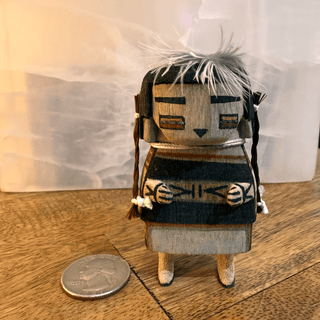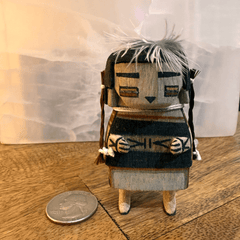Hand carved of the root of the cottonwood tree by Kevin Quanimptewa of the Tobacco clan from the village of Hotvela on Third Mesa.
The root of the cottonwood tree is used as it grows only where there is an ample and consistent supply of water - rare around the Hopi mesas - and because of the water-seeking nature of the roots, which can grow out and down a couple hundred feet or more in search of the water table.
Katsinas (kachina) are masked dancers and carved wooden dolls who embody different spirits during sacred ceremonies of the Hopi people. These sacred figures act as intermediaries between the human and spirit worlds, influencing natural phenomena like rain and crops, and are central to Hopi, Zuni, and other Pueblo religious practices, as well as being popular collectibles. A kachina (Katsina) may represent the spirit of animals, plants, people, places, or forces of nature.
This particular carving represents Hano Mana - Rain Maiden as she appears during the Powamuy or Bean Ceremony which is an early planting ceremony.
Approximately 3 inches tall and 1-1/2 inches wide.
Hand carved of the root of the cottonwood tree by Kevin Quanimptewa of the Tobacco clan from the village of Hotvela on Third Mesa.
The root of the cottonwood tree is used as it grows only where there is an ample and consistent supply of water - rare around the Hopi mesas - and because of the water-seeking nature of the roots, which can grow out and down a couple hundred feet or more in search of the water table.
Katsinas (kachina) are masked dancers and carved wooden dolls who embody different spirits during sacred ceremonies of the Hopi people. These sacred figures act as intermediaries between the human and spirit worlds, influencing natural phenomena like rain and crops, and are central to Hopi, Zuni, and other Pueblo religious practices, as well as being popular collectibles. A kachina (Katsina) may represent the spirit of animals, plants, people, places, or forces of nature.
This particular carving represents Hano Mana - Rain Maiden as she appears during the Powamuy or Bean Ceremony which is an early planting ceremony.
Approximately 3 inches tall and 1-1/2 inches wide.




